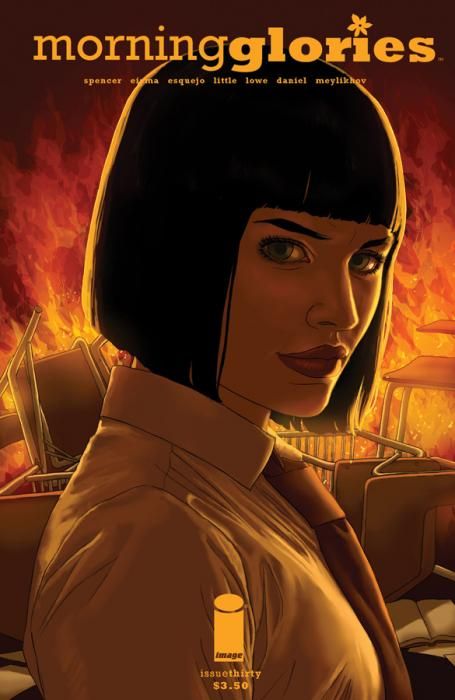"Morning Glories" #30 by Nick Spencer and Joe Eisma is all about Irina. The second major storyline of "Morning Glories," "All Will Be Free" began by spotlighting the Original Glories, giving Zoe, Hunter, Jun, Jade, and Ike, devoting one issue to each of them. It's like dejà vu as Season Two's second story arc begins with a spotlight on Irina's back story and current predicament. Just like Zoe, the murderous "mean" girl of the Original Glories ushered in characters spotlights in issue #7, dark-haired, trigger-happy Irina (ironically, Zoe's killer) begins the lineup for the Truants.
"Morning Glories" #30 has a lot of facts on where Irina came from and where she is now, but Spencer stops short of giving the reader an origin story. In other words, Spencer addresses the who, what, when, where and how, but the reasons why Irina and her mother have acted are not given to the reader.
As always, Spencer's plot twists are impressive for their surprise factor and unpredictability, and Irina's story contains at least two revelations that no reader will be able to see coming, one regarding Irina's sister, the other about how Irina ended up at the Academy.
Irina's mother, Kseniya, was by any normal measures abusive, but the abuse is softened, perhaps even actually justified, because the story also hints that Kseniya was neither paranoid nor unhinged. The ability of the reader to empathize with Irina is also made difficult by how foreign her experience is. The "lesson" of 5 hired rapist/killers is far beyond normal experience. Irina's trials also echo Spencer's larger, biblically-influences themes of parenthood and rebellion, sacrifice and faith. However, while these facts explain Irina, they don't humanize her.
Eisma's art is where the characterization comes through. The maltreatment of a beloved animal is a well-worn way to demonstrate parental hard-heartedness and brutality. In the hands of another artist, the fate of Irina and her dog Snowflake might feel stale, but Eisma makes the scene come off with his superlative facial expressions and body language. Also, he knows how to de-age characters realistically, including making young Irina's movements more ungainly and cute.
The pacing throughout "Morning Glories" #30 is excellent. Spencer's technique of jumping back and forth in time works well to draw a contrast between the scared, more vulnerable and more "normal" child Irina to the confident, more-at-peace and yet much more difficult-to-understand and dangerous current-day Irina. In the beginning two sequences, Spencer and Eisma draw out both the suspense of the brutal, slightly bloody fight in the past and the reader's curiosity about where Irina is now. The two successively more desperate battle scenes between Irina and Kseniya show off Eisma's cinematic storytelling. He ups the panel-to-panel visual tension in sync with the rising stakes of combat.
"Morning Glories" #30 also continues the feature of a Morning Glory Academy Study Hall notes by Matthew Meylikov and a cartoon with MGA babies/chibis by Meylikhov and Eisma. Meylikhov's speculation and point-by-point analysis is thoughtful, especially his attention to themes and allusions. Long-time readers will appreciate the in-jokes in the cartoon. While these backup features aren't strictly necessary, for an ongoing series with a complex timeline and currently-unresolved mysteries great and small, they are a great way (like a letters page, but better tailored to the purpose) to give committed readers a community.
Like the series as a whole, "Morning Glories" #30 is well-plotted and drawn, and Irina's story will keep the reader guessing and looking forward to more character spotlights.

